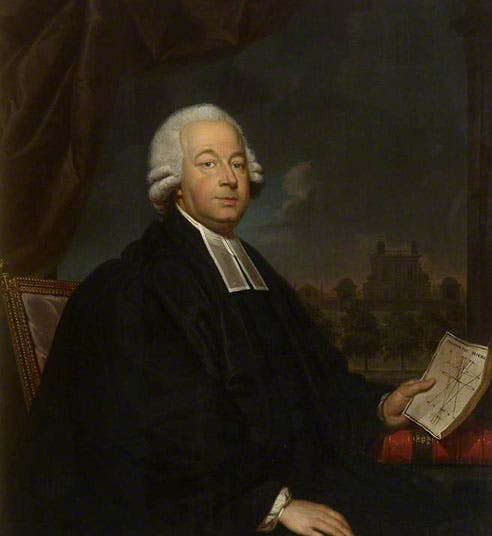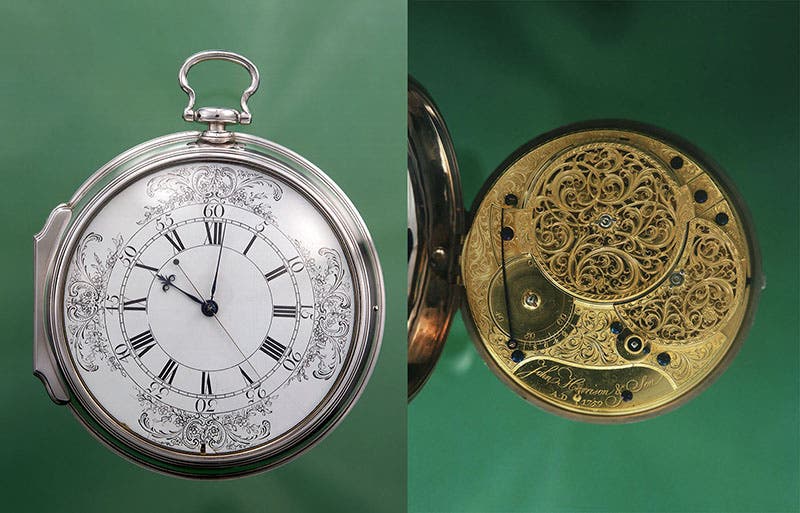Scientist of the Day - Nevil Maskelyne
Nevil Maskelyne, an English astronomer and cleric, was born Oct. 5, 1732, in London. He became interested in astronomy after observing an eclipse when he was 16 years old, and although he served for a time as an Anglican minister after graduation from Cambridge, it would be the more material heavens that would occupy his attention for the bulk of his life. He became interested early on in "the longitude problem" – finding a way to determine longitude at sea from the deck of a moving ship. It was a matter of such concern to the Royal Navy that Parliament in 1714 had offered a prize of £20,000 to anyone who could establish longitude at sea to within half-a degree, or 34 miles, and had set up a Board of Longitude to oversee the competition for the prize.
Maskelyne became a proponent of what was called the "lunar-distance method." Since the Moon moves quite rapidly against the background stars – it covers its own diameter in just an hour – then it ought to be possible to measure the distance of the Moon from some standard star at a certain time. If one knew at what time the Moon was that distance from that star at a standard location, such as Greenwich Observatory, then the time of your observation aboard ship could be used to determine the time difference between the ship and Greenwich, and thus the difference in longitude (see diagram, second image). That was the theory, which as an idea, was centuries old. The problem was that, to be of any practical use, the lunar-distance method required exact positions of the stars and the Moon, and precision sighting instruments that could be used aboard ship. Nevertheless, it seemed feasible, and the third Astronomer Royal, James Bradley, worked for decades to obtain better observations of the stars to support the lunar-distance method. Maskelyne followed Bradley’s lead
But there was another possible approach to solving the problem – build a better timekeeper. If one knew the precise time difference between a ship at sea and Greenwich, then the longitude could be determined directly, with no need for any astronomical observations. If your “noon” comes 6 hours later than noon at Greenwich, then your longitude is 90° west of Greenwich; it’s as simple as that. The London instrument-maker John Harrison took this approach, building chronometer after chronometer, each one more accurate than its predecessor, until by 1760, he was ready to submit a sea-watch, called H4, for trials at sea (H1-H3 being the earlier precision chronometers). The Board of Longitude instructed that H4 be taken on a trans-Atlantic crossing to Jamaica, in 1761. Harrison's H4 (third image) worked nearly perfectly, losing only 5 seconds on the 80-day voyage, establishing the longitude of Kingston with less than a two-mile error, well within the prize requirements. Meanwhile, Maskelyne was sent to observe the Transit of Venus of 1761 at St. Helena, and he used the occasion to try out the lunar-distance method, with some success.
The Board was unsatisfied with the results of Harrison's trial, and requested a second Atlantic crossing in 1764, on which three methods were to be tested: the chronometer, the lunar-distance method, and one using the satellites of Jupiter. Maskelyne was sent along to conduct the tests of all three. This time, Harrison’s chronometer was accurate to within 10 miles, which again met the criteria of the contest, while the lunar distance-method was accurate to within 30 miles, which barely satisfied the requirements. Still, the Board refused to award the prize to Harrison, and Maskelyne wrote a negative report, saying that the chronometer had built-in errors which just happened to cancel each other out. Then Maskelyne became Astronomer Royal in 1765, when the incumbent of two years died suddenly, and thus became an ex-officio member of the Board of Longitude, where he continued to resist Harrison's claim for the award. Poor Harrison had to petition Parliament, and then the King directly, to finally get compensation, and the award itself was never actually given out. Harrison laid most of the blame for the 12-year delay at the feet of Maskelyne, whom he hated with a passion. Dava Sobel, in her superb book Longitude (1995), tended to agree with Harrison that Maskelyne unreasonably resisted Harrison’s petition for his award, and failed to recognize the significance of the marine chronometer, although, as she says, Maskelyne seems to have been more hard-headed than hard-hearted. And it is not surprising that an astronomer would prefer an astronomical solution to the longitude problem over one offered by a mere clockmaker.
There were undoubtedly some positives in Maskelyne’s long reign as Astronomer Royal (1765-1811), but why water down a good story by including them here? We can always write a second post if we feel a need to redress an imbalance.
William B. Ashworth, Jr., Consultant for the History of Science, Linda Hall Library and Associate Professor emeritus, Department of History, University of Missouri-Kansas City. Comments or corrections are welcome; please direct to ashworthw@umkc.edu.









